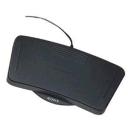Using the Java Media Framework is an easy way to build java applications that can record, edit, and play videos, but the number of video codec's that it supports is limited. Unless you want to go with a quicktime format, MPEG1 is a good choice (although the files can be a bit large) for portability. When starting with digital video, you can use ffmpeg to convert and encode the video as follows: Continue reading
Category Archives: Linux
Hacking the LG CU-500 with BitPim
One nice thing about the LG CU500 Phone is that BitPim (an application that works on Linux as well as windows) will allow you to edit it's file-system easily. This makes it relatively easy to modify some of the bad things that Cingular has done to the phone.
By default, Cingular locks the phone down so that unsigned Java Apps are forced to ask for Internet access on every single URL they load. Needless to say, this is very annoying when using a network based application such as Google maps.
Using a Sony FS-85 foot control with Linux and Mplayer
While transcribing, I wanted to use a Sony FS-85 foot control unit to pause and rewind the audio while I typed.
When plugged into linux it appears as a keyboard and gives various key-press codes when you hit the left or right petal. (The right side gives F10 when you press down, F11 when you release, etc). I was able to make this control Mplayer by adding a ~/.mplayer/input.conf file with the following lines in it:
Changing timeout time for mounting encrypted partitions on Mandriva
If you have an encrypted partition in Mandriva 2007, by default on boot-up the system gives you only 5 seconds to say you want to mount it on boot-up, which can be very easy to miss. If you edit the /etc/sysconfig/autofsck file to change the AUTOFSCK_CRYPTO_TIMEOUT= variable to something longer (such as 45) it will give you plenty of time.
Search and Replace a string in many files recursively on unix
find /net/hc287/summetj/research/dist1 -name "Root"
-exec perl -pi.bak -e's/summetj\@flux.cc.gatech.edu:/summetj\@wilks1.cc.gatech.edu:/g' {} \;
The above command line will find all files named "Root" recursively under the /net/hc287/summetj/research/dist1 direcotry and execute perl to replace the string "summetj\@flux.cc.gatech.edu:" with the string "summetj\@wilks1.cc.gatech.edu:" It also keeps a backup of all the changed files as Root.bak, just in case….
The {} is replaced by the find command with the name of the file, while the \; tells find's -exec command where the program arguments end. The @ signs are escaped by \'s. This is useful if you need to search and replace a string in many files in a directory tree to update some settings, for example, if the CVSROOT machine has been changed from flux to wilks1 and you don't want to do a full new checkout of 45MB over a slow link.
Using bluetooth PAN / DUN on Samsung Blackjack with Linux
The key to teathering your linux laptop to your Cingular Blackjack phone is enabling the Bluetooth DUN profile on the blackjack. Although it shows up by default, it won't work unless you are running the Internet Sharing application. (Which, Cingular has hidden from you, yay carriers!) Continue reading
Finding bluetooth link keys under Mandriva ( /var/lib/bluetooth )
For some reason, Mandriva has moved the default bluetooth link key location from /var/lib/bluetooth to /var/lib/lib/bluetooth. So, if you are looking for link keys (to delete to force a new pairing, etc) add an extra lib.
How to locate the Bluetooth DUN (Dial Up Networking) profile of a phone
When running linux, you sometimes want to connect to a cell phone (using it as a modem) over bluetooth.
Different cell phones use different RFCOMM channels to export their Dial-up Networking service on.
Here are the commands to use to find which channel you should use: Continue reading
Logitech Webcam for Notebooks Pro on Linux
 Logitech QuickCam Pro for Notebooks (USB) is the USB web-cam I use. I like the small size and the clip on mounting system works great with the IBM X31 Thinkpad.
Logitech QuickCam Pro for Notebooks (USB) is the USB web-cam I use. I like the small size and the clip on mounting system works great with the IBM X31 Thinkpad.
Mandrake 10.1 includes PWC (Philips Web Cam, the chipset that is used) support out of the box, but it only supports QCIF images (176×144, quite small) images. To get support for full size images (up to 640×480) you will need to install the kernel source rpm, and visit this site to download the pwc-10 package. I had no problems installing it from the full source code (as opposed to just the kernel patches). Continue reading
How to use a T-Mobile cell phone as a bluetooth modem from Linux
Short instructions on how to use a Bluetooth enabled cell phone as a modem (allowing you to log into the Internet while mobile). A few of the commands are T-mobile specific (Look for internet3.voicestream.com), but most of the rest would apply to any service provider. With T-Mobile, you must have an activated data plan to use your phone as a modem. I am grandfathered into a plan called "T-Mobile Internet VPN" for 19.95 a month, but believe the current rate is closer to $40 a month. Continue reading
